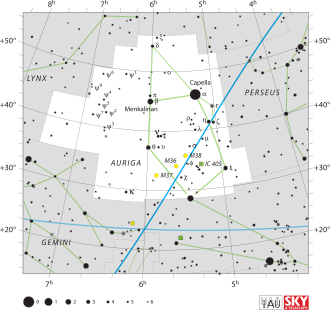HD 51418
| Observation data Epoch J2000.0[1] Equinox J2000.0[1] | |
|---|---|
| Constellation | Auriga |
| Right ascension | 06h 59m 20.12818s[1] |
| Declination | +42° 18′ 53.1147″[1] |
| Apparent magnitude (V) | 6.67 |
| Characteristics | |
| Spectral type | A0 SrCrEuDy,[2] A0pEuSrCrMgII[3] |
| B−V color index | 0.09[1] |
| J−H color index | -0.087[1] |
| J−K color index | -0.037[1] |
| Variable type | α2 CVn variable[2] |
| Astrometry | |
| Radial velocity (Rv) | −22.5±3.0[4] km/s |
| Proper motion (μ) | RA: -1.210[1] mas/yr Dec.: −6.792[1] mas/yr |
| Parallax (π) | 5.6092±0.0929 mas[1] |
| Distance | 581 ± 10 ly (178 ± 3 pc) |
| Details | |
| Mass | 3.557±0.178[5] M☉ |
| Radius | 3.297±0.165[5] R☉ |
| Other designations | |
| AG+42° 775, BD+42°1629, Gaia DR2 951315950188279424, GC 9158, HD 51418, HIP 33643, SAO 41475, PPM 49494, TIC 192072521, TYC 2950-1335-1, GSC 02950-01335, 2MASS J06592013+4218531, NY Aur, Renson 14180[1] | |
| Database references | |
| SIMBAD | data |
HD 51418 (NY Aurigae) is an Ap star and an α2 CVn variable located about 178 parsecs (580 ly) away in the northern constellation of Auriga. With an apparent magnitude of 6.67 and a spectral type of A0, it can be faintly visible by the naked eye as a whitish dot under very good circumstances. The star has been noted as an "extreme lanthanide star,"[6] with an overabundance of metals including europium, dysprosium, and holmium, which can be observed in the star's spectra as emission lines.[2][7]

In 1972, Austin F. Gulliver et al. announced that HD 51418 is a variable star.[9] It was given its variable star designation, NY Aurigae, in 1975.[10] HD 51418 possesses a strong magnetic field, which fluctuates in strength between −22–75 milliteslas (−220–750 G).[11] The magnetic minimum is known to occur concurrently with the minimums in luminosity and rare-earth detection.[7]
Visual companion
[edit]Speckle imaging observations conducted in 2009 revealed a previously unresolved companion star at a separation of 0.15 arcseconds. The secondary star, component "B" of the double star WDS 06593+4219 as designated in the Washington Double Star Catalog, is an F-type star with an apparent magnitude of 10.0.[12][13]
See also
[edit]References
[edit]- ^ a b c d e f g h i j "HD 51418". SIMBAD. Centre de données astronomiques de Strasbourg. Retrieved 24 September 2024.
- ^ a b c Bychkov, V. D.; Bychkova, L. V.; Madej, J. (2021). "Catalog of averaged magnetic phase curves of stars: Second edition". Astronomy & Astrophysics. 652: A31. arXiv:2004.14099. Bibcode:2021A&A...652A..31B. doi:10.1051/0004-6361/202040215. ISSN 0004-6361. Record for this source at VizieR.
- ^ Pyper, Diane M.; Adelman, Saul J. (1 August 2021). "Light Curve Changes and Possible Precession in mCP Stars". Publications of the Astronomical Society of the Pacific. 133 (1026): 084203. Bibcode:2021PASP..133h4203P. doi:10.1088/1538-3873/ac1ac0. ISSN 0004-6280.
- ^ Brandt, Timothy D. (1 June 2021). "The Hipparcos–Gaia Catalog of Accelerations: Gaia EDR3 Edition". The Astrophysical Journal Supplement Series. 254 (2): 42. arXiv:2105.11662. Bibcode:2021ApJS..254...42B. doi:10.3847/1538-4365/abf93c. ISSN 0067-0049.
- ^ a b Kervella, Pierre; Arenou, Frédéric; Mignard, François; Thévenin, Frédéric (2019). "Stellar and substellar companions of nearby stars from Gaia DR2: Binarity from proper motion anomaly". Astronomy & Astrophysics. 623: A72. arXiv:1811.08902. Bibcode:2019A&A...623A..72K. doi:10.1051/0004-6361/201834371. ISSN 0004-6361. Record for this source at VizieR.
- ^ Hümmerich, S.; Paunzen, E.; Bernhard, K. (2020). "A plethora of new, magnetic chemically peculiar stars from LAMOST DR4". Astronomy & Astrophysics. 640: A40. arXiv:2005.14444. Bibcode:2020A&A...640A..40H. doi:10.1051/0004-6361/202037750. ISSN 0004-6361.
- ^ a b Jones, T. J.; Wolff, S. C.; Bonsack, W. K. (1974). "The Holmium AP star HD 51418". The Astrophysical Journal. 190: 579. Bibcode:1974ApJ...190..579J. doi:10.1086/152913. ISSN 0004-637X.
- ^ EAS (1997). "The HIPPARCOS and TYCHO catalogues". Astrometric and Photometric Star Catalogues Derived from the ESA Hipparcos Space Astrometry Mission. ESA SP Series. 1200. Noordwijk, Netherlands: ESA Publications Division. Bibcode:1997HIP...C......0E. ISBN 9290923997. Retrieved 15 October 2022.
- ^ Gulliver, A. F.; Macrae, D. A.; Percy, J. R.; Winzer, J. E. (February 1972). "The spectrum and light variations in the peculiar A star HD 51418". Journal of the Royal Astronomical Society of Canada. 66: 72. Bibcode:1972JRASC..66...72G. Retrieved 30 November 2024.
- ^ Kukarkin, B. V.; Kholopov, P. N.; Kukarkina, N. P.; Perova, N. B. (January 1975). "60th Name-List of Variable Stars" (PDF). Information Bulletin on Variable Stars. 961. Bibcode:1975IBVS..961....1K. Retrieved 30 November 2024.
- ^ Campos, L. M. B. C. (11 January 2011). "On magnetoacoustic-gravity-inertial (MAGI) waves - II. Application to magnetic and rotating stars: MAGI waves in magnetic and rotating stars". Monthly Notices of the Royal Astronomical Society. 410 (2): 735–761. doi:10.1111/j.1365-2966.2010.17552.x. Record for this source at VizieR.
- ^ Balega, Yu. Yu.; Dyachenko, V. V.; Maksimov, A. F.; Malogolovets, E. V.; Rastegaev, D. A.; Romanyuk, I. I. (2012). "Speckle interferometry of magnetic stars with the BTA. I. First results". Astrophysical Bulletin. 67 (1): 44–56. Bibcode:2012AstBu..67...44B. doi:10.1134/S199034131201004X. ISSN 1990-3413. Record for this source at VizieR.
- ^ Mason, Brian D.; Wycoff, Gary L.; Hartkopf, William I.; Douglass, Geoffrey G.; Worley, Charles E. (2001). "The 2001 US Naval Observatory Double Star CD-ROM. I. The Washington Double Star Catalog". The Astronomical Journal. 122 (6): 3466–3471. Bibcode:2001AJ....122.3466M. doi:10.1086/323920. Record for this source at VizieR.

